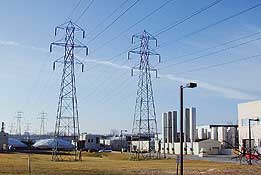With a population of 22,000 people, Geneva, Ill., is a typical Midwestern suburb. But inside city hall, officials are clamoring for more powerthe electrical kindand they have succeeded. Geneva is building a 29-Mw, natural-gas-fired plant that planners hope will bring energy independence to residents and businesses.
Users hit hard by todays erratic cost of transmitted energy are showing noticeable interest in meeting peak power needs with distributed generation (ENR 4/9/01 p. 44). But economics is not the only reason. Despite the high up-front investment, these pocket powerplants sited near the demand may gain even more popularity as users evaluate the need for reliable, local power during mass outages, such as the grid meltdown the Northeast experienced on Aug. 14.
 |
| Geneva's 29-Mw plant cost $17 million. (Photo top courtesy of Caterpillar Inc.) |
The U.S. derives 10% of its current electrical capacity from distributed generation, totaling about 60 Gw, according to John Kelly, director of Gas Technology Institutes Distributed Energy Technology Center, Des Plaines, Ill. Kelly estimates the market has a 100 Gw potential by 2012, the bulk of which is likely to be be in and near urban areas.
Geneva fits the bill, located about 40 miles directly west of Chicago. "I think DG has more people looking into it," says Joseph Summers, vice president of HWS Energy Partners and president of Industrial Technology Group. Geneva hired the Champaign, Ill.-based firms for construction management and electrical engineering services, respectively, for its $17-million facility, which Summers says is 75% completed. The 10,000-sq-ft powerplant will house five 5.9-Mw generators powered by natural-gas-fired reciprocating engines. Costing $11 million, the 8,000-hp Caterpillar engines are 40 ft long, 15 ft tall and 10 ft wide. The city estimates the plant will help save $177 million in peak energy costs over 40 years.
 |
| Cleveland Water treatment plant are investigating new backup. (Photo courtesy of NorthEast Ohio Regional Sewer District) |
"Historically, we have owned our own power utility, but to date, we have not generated power," says Phil Page, Genevas city administrator. "In the uncertainty in the deregulated market, we think our rates will definitely be going up [and] we felt it was important to try to control some of our destiny."
Geneva officials initially decided to build the plant to offset energy costs, but it will help out during power outages as well. If Chicago ever experienced a blackout like Aug. 14, the new powerplant will be able to supply electricity to Geneva residents, but "we wouldnt have the capacity to keep our businesses running," says Page. "The bottom line is to get the lights back on as fast as possible," says James Greever, Genevas electrical superintendent. "Economics is a major driving factor. Beyond that, it is local control and reliability."
Geneva is not alone. Water treatment officials reeling from the unexpected blackout in Cleveland say they now are planning to hire consulting engineers to study additional power options. The backup diesel generators in their facilities were designed only to handle critical loads, not full operations.
"We do not have major backup or alternative energy when the grid goes down," says Tim Tigue, director of operations and maintenance for the Northeast Ohio Regional Sewer District. "In the next couple of months, we are definitely going to look at alternative supply."
A self-described proactive utility operator, Greever expects major construction of Genevas gas-fired plant to wrap in January. It should be ready to supply peaking power by next summer, he says.
|
